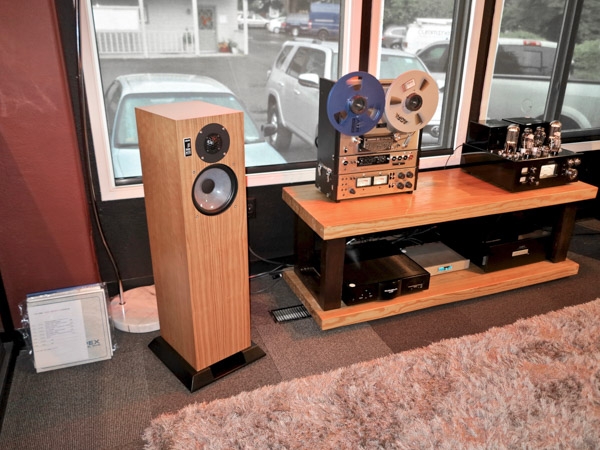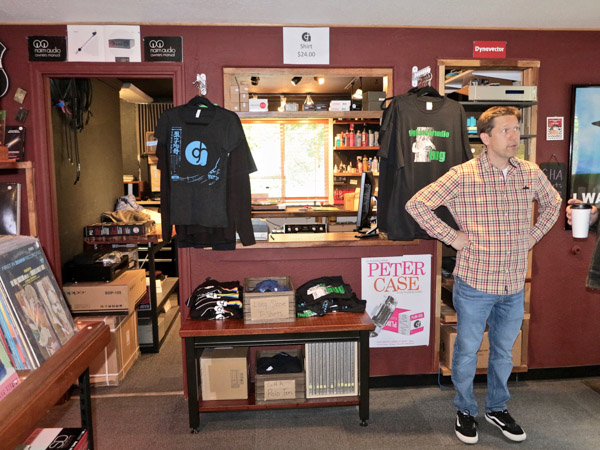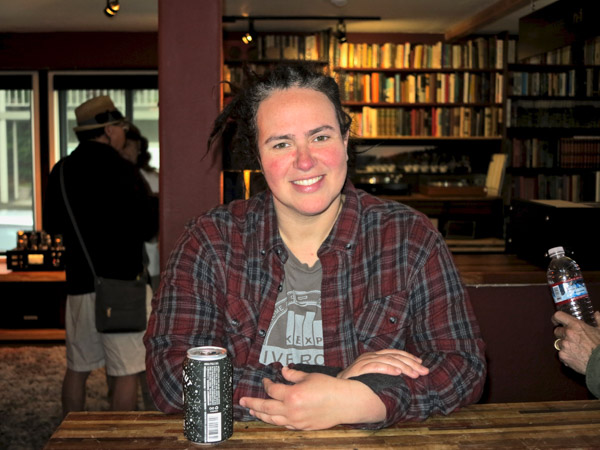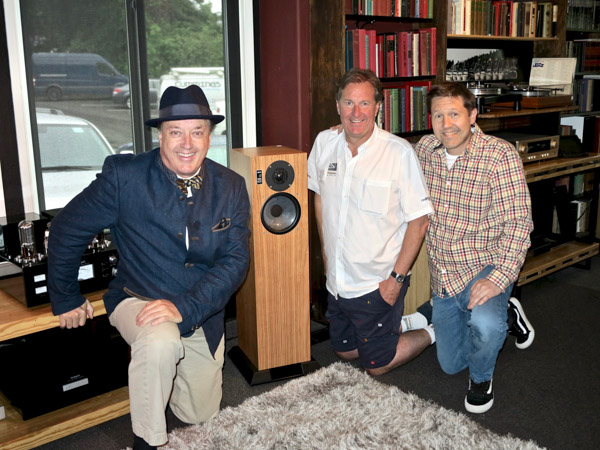| Columns Retired Columns & Blogs |
Looking forward to the review of the new Krell K-300i integrated amp ......... As Arte Johnson would say, should be "Verrrry interesting" :-) .........

Most of my listening was to a 15ips tape of select jazz and classical tracks prepared by Yarlung Records—everything from “Missing Miles” from Yuko Mabuchi Plays Miles Davis to Jung-A Lee’s Fantasia from A Private Organ Recital in Walt Disney Hall and mezzo-soprano Sasha Cooke’s Handel. Using an old Pioneer tape deck, Gig Harbor Audio cabling assembled with Dueland wire, and power treatment that included AudioQuest’s PowerQuest 2 and NRG Edison duplex wall outlets, we listened through two very different-sounding integrated amps, the 30Wpc, single-ended Line Magnetic LM845 Premium ($7500 right now, $8000 in a week due to tariffs) and brand new, hardly broken-in 200Wpc Krell K-300i ($7000, $8000 with streaming DAC; review forthcoming). The LS5/9f made it easy to hear how different those amps sound.

The three-hour launch event took place in a relatively intimate space. It was not a quiet space: Owen wants his shop to be friendly. To quote GHA fan Casey Richardson of Federal Way, WA, “How many other hi-fi stores are there where you can sit around and have a beer and talk to people and talk shop all at the same time? I’ve met new friends here; we all go to each other’s houses to listen. This isn’t just a hi-fi shop; it’s a community of people that love hi-fi.”

That’s another way of saying that while lots of people took turns listening on the store’s comfy couch or standing near the sweet spot—a bunch arrived well before the event started—just about everyone spent the bulk of their time sipping beer while chatting informally with new and old friends, including Graham Audio founder Paul Graham, Graham distributor Philip O’Hanlon (On a Higher Note), and store owner Erik Owen.
O’Hanlon was the impetus for the development of the LS5/9f. “[We] were listening to Graham Audio’s little LS5/9 last year, and we were smitten by its midrange magic and how it could sound so good with whatever electronics and cables I had lying around,” he told me. “But we felt that floorstanders would sell better in the US.”

Graham agreed. “A lot of buyer’s spouses didn’t like the look of the stands,” he explained during our 40-minute chat. “This new LS5/9f is based on the classic BBC LS5/9 monitor, but it has about 5Hz more bass extension. We’ve tried to retain the same studio-grade quality and strengths of its monitor predecessor while extending the bass lower. As for its price, when you take the monitor and figure in the cost of good stands, it’s about the same.”
Lovers of the BBC speaker sound probably already know much about the genesis of Graham Audio. “Over 30 years ago, I was buying and selling equipment and started buying stuff from the BBC,” Graham said. “Even if the BBC speakers were in poor condition, we were getting good money for them. So I asked the BBC if I could get a license to reproduce them. Since Rogers had stopped doing everything apart from the 3/5a, they said, ‘Sure.’”
Graham started with the 5/9, but after talking with O’Hanlon, began producing the 5/8, then the 3/5, and then the LS3/5A under license from the BBC. The crossover design remains, but Graham says the speakers are “much better than they used to be because they’re using better components. “Derek Hughes, the son of Spendor founder Spencer Hughes, does all our ‘re-creation’ work for us. Derek has the knowledge from working with his dad, and still has his dad’s notes at home. Everything we do has good lineage, as it were.”
Graham maintains that while the BBC designs were solid, the speakers weren’t particularly well-made. Their early propylene drivers deteriorated “quite badly” with the passage of time, for example, and their capacitors weren’t as good as many modern varieties. In addition, because the performance of supposedly identical tweeters varied widely in the ‘70s, the original 5/9 had a solder pin adjustment on a Traffolyte plate on its front, which enabled owners to solder wire from common to either +.5, +1,+ 1.5 or +2—whatever was necessary to balance the tweeters. The new LS5/9f follows that example with a HF level switch on the front. (We listened with the tweeters set flat.)
The LS5/9f is so new that it has yet to appear on the Graham Audio website, but Derek Hughes sent along specs: Sensitivity is 87dB / 2.83V/ m; nominal impedance is 8 ohms; recommended amplifier power is 50–200 watts; maximum output exceeds 100dB for a pair at 2m; and frequency response is 45Hz-18kHz ±3dB. Drivers are a 34mm soft dome tweeter from Audax and a long-throw 200mm Diaphnatone Polypropylene bass/midrange custom-made for Graham Audio by Volt.
Look for Art Dudley’s comparison of the Graham LS3/5, LS3/5A, and Falcon LS3/5a in our July issue.

Looking forward to the review of the new Krell K-300i integrated amp ......... As Arte Johnson would say, should be "Verrrry interesting" :-) .........

... correct output power specification for the Krell K-300i.
http://www.krellonline.com/integrated-amps.html#K-300i

JVS was concentrating on how the equipment was reproducing the music ....... So, such minor details as power output were not as important :-) ........

... suggests that JVS lacks much familiarity with open-reel tape machines.
Harbeth's designer would assert that his speakers are superior to all others that lay claim to BBC heritage because their main drivers have the advantage of incorporating the special 'Radial' plastic cone material he had developed. Likewise, he would cite stand-mounting to be an advantage since it allows the speakers to be positioned with the reference axis precisely level with the listener's ears by choosing stands of the appropriate height.
If and when Stereophile receives a pair of Graham Audio LS5/9f speakers for evaluation, could it also be arranged to obtain a pair of the comparably priced Harbeth SuperHL5plus speakers (and stands) for direct comparison? Or, perhaps, HR could do the review and compare the Grahams with his Harbeth 30s?

If and when Stereophile receives a pair of Graham Audio LS5/9f speakers for evaluation, could it also be arranged to obtain a pair of the comparably priced Harbeth SuperHL5plus speakers (and stands) for direct comparison?
Not precisely what you're seeking, but you should enjoy Art Dudley's column in the July issue of Stereophile.

May be Jim Austin could review the new Krell Solo 575-XD mono-block amps? ....... If he still has the Revel Ultima Salon2 speakers, that would be a great match :-) .........


Good stuff deserves pages and time ........ Keep Stereophile great :-) ........

We are all happy that Stereophile is in good hands ...... as always has been :-) .........

... include measurements.
The comment about none of the speakers being able to reproduce fundamental tones below 70 or 80kHz was intriguing.
If AD was casting about for a low power amp to use with LS3/5a speakers, he should have tried an old Advent receiver. That combo made a great dorm room system forty years ago.


Everything old is new again :-) ........
What goes around comes around :-) ........

Martin Logan Monolith III with Exos...
1990, 3500 dollars.
1000 dollars passive.
You can Google the model for pics.
Times sure change.

DJIA was 2,810 in 1990 ......... Now in June 2019, DJIA is more than 25,000 ....... Hope you were investing during this time ........ :-) ............

1 MHz Apple computer was 2,500 bucks in 1991.
These multi GHz machines must cost 4 billion dollars.
Just saying, compare the two speakers.

I'm sure you invested in Apple in 1991 :-) .........

BTW ..... Check out the new Apple Mac Pro top of the line computer with 28 core processor and 32" 6k display coming out this fall :-) .........

Apple is starting to base its business model on selling Giffen Goods.
Sorta like our own hobby!
I say that as I am saving up for some speakers the price of a car.
I should buy Stockholm Audio "Syndrome" speakers.
;-D
Do you think there are technophiles on some forum right now telling people that the new thousand dollar iMac display stand is a high end stand performer? Do you think they defend its value and tell display skeptics that this iMac stand lifts several retinal veils? It's made from billet aluminum and requires stand artisans 6 weeks to arrive at a final product?
I do believe that (even loving the hobby as much as I do) we do need to be able to call bullshit on each other without scarlet letters being sewn on our listening gowns and branded as haters.
It's an odd line between journalism and sycophancy.
Again, saying that as an avid audiophile.

Which speakers and what car? :-) .......
If you invested in Apple in 1991, you could now in 2019, buy Wilson WAMM speakers and a Rolls-Royce Phantom .... and, D'Agostino Relentless mono-blocks to drive those WAMMs .......... Rolls-Royce Phantom comes with Lexicon surround sound system with 13 strategically placed speakers and, a couple of subwoofers placed in the floor :-) ........

... Ronald Wayne.

Ronald Wayne may not be an audiophile ........ Steve Jobs and Steve Wozniak were/are supposed to be audiophiles :-) ...........
If, Steve Jobs had an opportunity to listen to WAMM, D'Agostino and Rolls with Lexicon, he might have said, this stuff is 'insanely great' :-) .........

Ronald Wayne OTOH is happy, listening to music via his latest generation iPhone and Beats Bluetooth ear-phones ........ He bought those with the money he made from selling his shares of Apple stock :-) ........

The LS5/9 was a 2-way thin wall standmount. The Habeth LS5/9 derivative is the M30.1 or M30.2, not the SHL5+.
This seems to be a rigid cabinet and obviously not a standmount. So the whole point of soft wall cabinets, which is to eliminate resonance and ringing, is lost, and the floor standing cabinet will have completely different properties.
Whatever it is, and however, good it is, or isn't, it isn't an "LS" or BBC type speaker.
The M30.1 is $5,500 and this is $8,000. Even the M30.2 special edition is $6,500.
Why have they decided to do this at all, and how does it compare to their LS5/9 thin wall standmount?
The original drivers that the BBC used have of course been improved upon, after all they were made over 40 years ago and materials science for drivers has moved on for the better. They were hand coated and the better ones kept for the BBC, others for consumer manufacturers. They degraded and I have no idea why anyone still buys the reproduction LS3/5 units with bexdrene drivers.

... the Graham speakers are fabricated?
Do they start out as plastic sheet material which is heated and vacuum formed or are they injection molded from plastic pellets?